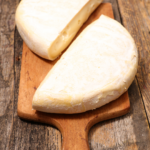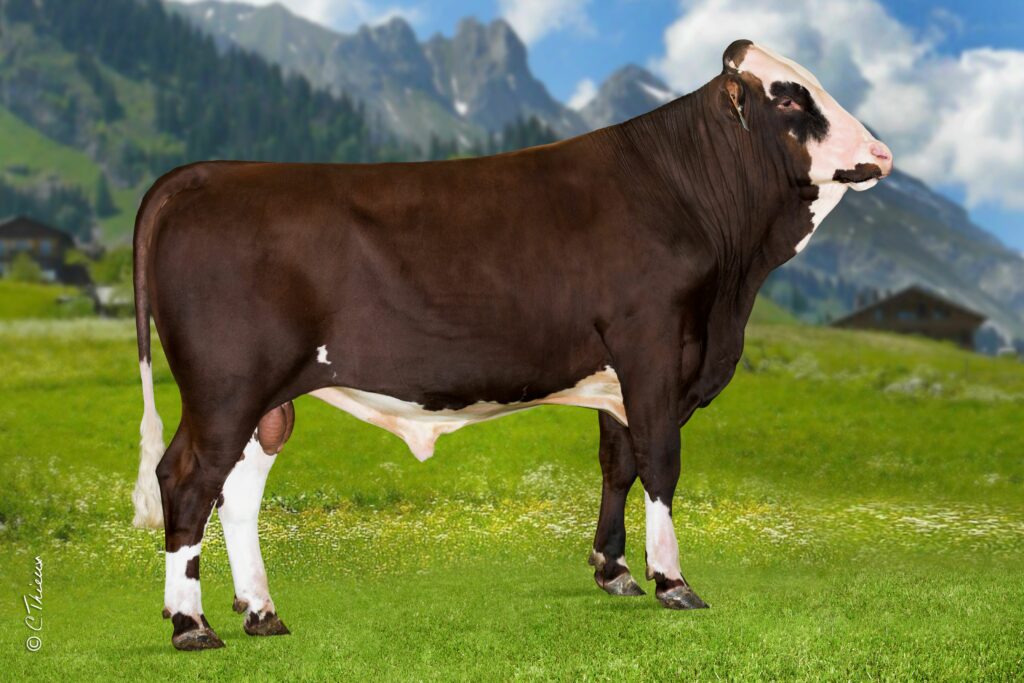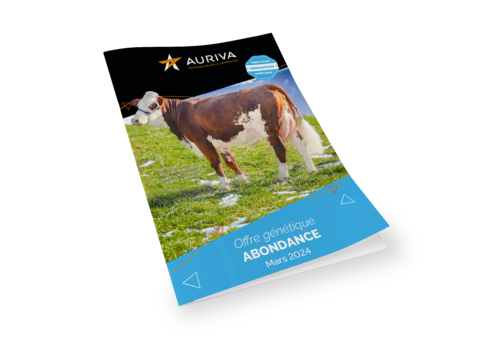
Detection of a genetic anomaly in the Bazadaise breed
27 March 2024
Tarine finds its place in the Pyrenees!
17 June 2024Meeting with GAEC LES ALPAGISTES in Megève (74): 90% Abondance and 10% Tarine mixed herd
GAEC LES ALPAGISTES is located in the commune of Megève in the Haute-Savoie department at an altitude of 1,200 m. Meeting with Guillaume and Aline MAILLET-CONTOZ.
Abondance, a breed that has been around for decades
Guillaume’s father, Gérard, took over the farm in 1986, following the cessation of dairy farming. He then keeps the buildings to breed Abondance heifers (purchase at 2 weeks, resale at 3 years).
In 2007, Guillaume settled down and decided to take over the dairy business, buying around forty head of cattle, mostly from neighboring breeders.
A nurse at Sallanches hospital for 5 years, Aline joined the GAEC in 2020, following the birth of their2nd daughter. Together, they created the current GAEC. The usable agricultural area (SAU) is 136 ha, of which 100 ha is alpine pasture in the commune of Praz sur Arly and 36 ha in the valley, divided into 25 ha suitable for mowing and the remainder for grazing.
Today, the herd comprises 40 Abondance cows and a dozen Tarine cows.
They produce 300,000 liters of milk a year, or an average of 5,800 liters of milk per cow.
Heifers are raised on the farm for up to 6 months, then spend 2 years in boarding workshops. They collect them in foal and calve them on the farm. Calving takes place from October to December (around 40 calvings), then around 15 from January to April, and around 10 on the mountain pasture in June-July.
The GAEC takes in a complete herd of 40 dairy cows for the season (GAEC FERME JACQUET). Milking and processing are then carried out in the mountain pastures. Of the 300,000 liters of milk produced, 220,000 L are processed directly on the farm. The remainder is delivered to two cooperatives (Beaufortin and Mont Blanc).
Why did you choose to process milk on the farm and deliver it through a cooperative?
” It’s a choice we’ve made since 2018 by building a cheese dairy on the farm. Our aim has always been to produce only PDO cheeses, not only for the quality of the cheeses themselves, but also to make the most of our raw materials.
We produce 90,000 liters of farmhouse Reblochon and 130,000 liters of farmhouse Abundance. Cheeses are delivered mainly to ripeners (Maison Pochat and Maison Paccard), but also to 7 local stores. We are finally selling a small volume at the farm store.
For the rest of our production, we deliver 50,000 liters to the Beaufortin cooperative and 30,000 liters to the Mont Blanc dairy cooperative for dairy Reblochon, and have been doing so since I set up in 2007.
The fact that our milk is delivered by a cooperative guarantees us a flow of milk, and also gives us a bit of a “breather” from the cheese-making process. We currently deliver 2 milkings a week and we’re thinking of going to 3-4 milkings a week.

What characteristics are unique to Abondance milk?
“Abondance milk is rich in TP, ideal for cheese production. The Abondance PDO requires us to have 45% Abondance cows. This was not a constraint for us, as the Abondance breed has always been at the heart of our business, and is THE obvious breed in the sector. My father was a member of the OS RAR right from the start, and took an active part in breed-related meetings. Since childhood, I’ve been rocked by this breed!
In terms of production, the aim is to achieve a good TB/TP ratio and maximum cheesability. We remain extremely vigilant about fat content. The OS and AURIVA are currently considering the reform of the ISU, with the aim of giving more weight to the rate in the calculation of the ISU, and will therefore reinforce our strategic orientations. “

How many liters of milk per cheese?
How are you involved in genetics at co-op and AURIVA level?
“Our selection objectives during planning are TB and udder position. We have been genotyping all our females since the service began in 2018. The first objective is to sort our heifers for renewal.
We use the EDS cooperative for inseminations. We only use purebred doses, except on returns where we use crossbreds.
The mating schedule is drawn up alternately by the OS technician and the AURIVA technician.
When it comes to planning, we essentially trust the technician’s choice, but if we have to choose between 2 bulls, we’ll choose the one that best meets our objectives (milk segment and rate).
It’s true that working with the AURIVA team is a real pleasure, because we’re surrounded by professionals who give us technical advice, but we’re still in control of our choices. We get real support on a daily basis, and that’s a real source of motivation. What’s more, the AURIVA commissions that select future sires for the catalog are made up of breeders from different areas, so we’re represented no matter where we come from!
We also call on the AURIVA TE team for embryo collection and placement. The aim is to breed 2 heifers a year: an Abondance and a Tarine.
We also appreciate their advice and support.”
3 AURIVA bulls born on the farm
“In 15 years, if you trust the AURIVA selection scheme, you can have a herd with good morphology and production.
We’ve had 3 bulls come into the center from our home since I set up.
IRRED, born in 2013, son of ARDECHOIS/CHATAIGNE, entered the center on ancestry. It was released following its known genotyping in 2015. Today, he still boasts a milk index of +1050 kg. Her mother CHATAIGNE was bought in 2007 when I moved in. She quickly stood out for her production (over 8000kg in her2nd lactation!). She had been chosen as a bull dam by the MAT commission at the time, made up of Yves Dunand and Eric Bouchex. Without them, she would have remained just another herd cow.
In 2016, when she was genotyped following the release of MUSH, she confirmed her dairy potential.
MUSH was born in 2016, son of DIMITRI and half-brother to IRRED. He was the offspring of a CHATAIGNE/DIMITRI embryo that had been targeted by the AURIVA selection scheme. Following his genotyping, he was selected to join the station and then to be distributed as a young sire in2018/2019. Now a confirmed sire, his impact will be consolidated in the coming years by his son RAYBAN, a young genomic sire last year.

Finally, ROCHEBRUNE born in 2020, son of NEPTUNE and NAOMIE (qualified as a sire dam by Yves Dunand): genotyped by AURIVA then selected to join the station. It was subsequently eliminated by the Genetics Commission and never distributed.
It’s a real source of pride for the farm to be involved in the selection scheme, because it proves to us that the work we put into genetics and the trust we place in our technicians pays off.
We hope to have more in the years to come!
"I encourage young people to set up in the Reblochon zone, and in the Abondance breed of course! We have a real industry that is there to support us in the event of problems, and to provide us with lasting, sustainable solutions. We're not alone. I often take trainees with us on the farm because it allows us to pass on what we were taught when we were young. Finally, the most important thing for a young person wanting to set up in Abondance is not to be afraid of investing in genetics, because it always pays off in the end!
Guillaume MAILLET-
How do you see the future?
“We don’t particularly want to expand the herd, but rather continue to advance in the 2 breeds at the same time and at the same level, progressing with the new technologies that may be offered to us.
The aim is to ensure the long-term future of the business, and perhaps one day convert the building back to loose housing. There’s also the question of whether to take on a part-time or full-time employee on the farm, so that we can free up our time and enjoy things with our families.
What’s certain is that any investments made on the farm will be made to ensure a smooth handover, either to our children or to a third party!
Finally, we want to continue to promote our milk and cheeses to consumers, because that’s what sets us apart today and makes us proud of our region.






